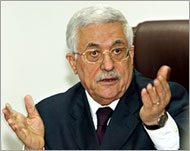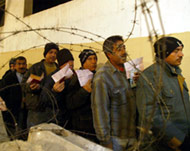Hamas reveals names of commanders
Hamas’ secretive military wing has emerged from hiding, revealing the names of seven top commanders and detailing how they masterminded attacks on Israelis.

The move is part of an increasingly fierce competition between resistance movements and the Palestinian Authority over who will get credit for Israel’s pullout from Gaza.
The battle over public opinion could determine who rules Gaza after the last Israeli soldiers leave on 15 September.
Hamas says it drove Israel out with attacks, while Palestinian President Mahmoud Abbas credits his non-violent approach.
On Saturday, a defiant Hamas delivered a new challenge to Abbas, who has come under increasing international pressure to disarm the group after the Israeli pullout, but is reluctant to do so.
On its website, the Hamas military wing, Izz al-Din al-Qassam Brigades, laid bare its command structure for the first time, posting names of seven top operatives, along with photos, biographies and interviews.
Hamas is also printing tens of thousands of flyers with the content of the website, to be distributed in coming days in mosques and at rallies.
Warning
The seven names were known to some in Gaza, but on Saturday marked the first time Hamas itself presented them in public, along with the commanders’ job titles.
 |
|
Mahmoud Abbas is trying to win |
At the top of the pyramid was Muhammad Daif, who has been No 1 on Israel’s wanted list for years, and has survived three attempts by Israel to kill him.
In comments posted on the website, Daif warned that Hamas would use force if Palestinian police tried to disarm or arrest members of the group.
“We will respond to any attack, whether from the authority or from the Israelis,” Daif was quoted as saying. “We will respond strongly to any attack on us.”
Daif also said that Izz al-Din al-Qassam Brigades would not disband, and instead continue to develop weapons, including rockets.
But his comments on whether the group would stick to an informal ceasefire with Israel, particularly after Israel’s Gaza pullout, were evasive.
Daif described how Izz al-Din al-Qassam gradually built bombs and rockets.
He said the group’s first attack, in January 1992, was the killing of a rabbi in the Israeli settlement of Kfar Darom in Gaza.
“He was shot by our brothers with a 7mm pistol … which was the only pistol that we had,” Daif was quoted as saying.
In 1995, after a few failures, Hamas built its first crude bombs, followed a few years later by rockets.
He said the most effective weapon were scores of bombings Hamas set off in Israel from the mid-1990s. Hundreds of Israelis, including many civilians, were killed in such bombings.
Nothing new
The other senior operatives named on the website were: Ahmad Jaberi, a Daif deputy; Raid Said, commander of Gaza City; Ahmad al-Ghandur, commander of northern Gaza; Muhammad Abu Shamala, commander of southern Gaza; Marwan Isa, a Daif deputy; and Muhammad al-Sanwar, commander of the town of Khan Yunus.
|
“They published what they assume the Israeli intelligence knows, to get credit from the Palestinian public” |
Three of the seven biographies were accompanied by headshots, while three others posed with masks. No picture accompanied the entry of the shadowy Daif.
The operatives described in some detail how they planned attacks.
Isa, for example, said Hamas operatives would watch an Israeli settlement targeted for attack for days and weeks.
He said he always had more volunteers for resistance missions than he could dispatch, and that dozens of attacks were called off at the last minute for fear of failure.
Boaz Ganor, an Israeli counter-terrorism expert, said Izz al-Din al-Qassam was not revealing secrets.
“They published what they assume the Israeli intelligence knows, to get credit from the Palestinian public,” he said.
Popularity concerns
Hamas is competing in parliamentary elections in January and appears reluctant to carry out attacks, amidst concerns it could lose popularity among voters if held responsible for provoking Israeli reprisals.
Hasan Yusuf, a Hamas leader in the West Bank, said Izz al-Din al-Qassam came forward “to show the role of resistance in liberating Gaza”.
Alluding to the competition with Abbas, he said: “They (the resistance) felt that there are some people who wanted to downplay the role of the resistance.”
 |
|
Gazans have been fenced in in the |
Abbas is also trying to win political capital from the Israeli pullout.
In a visit to Palestinian schools at the start of the new school year on Saturday, Abbas emphasised that the Israeli pullout would improve daily life.
“God willing, the people will live in peace and security,” Abbas told students in Gaza City.
“The Israeli attacks will end, and then people will enjoy freedom of movement.”
Israel has demanded that Abbas disarm Hamas – in line with Palestinian obligations under the US-backed road map peace plan.
Israel also opposes the participation of Hamas in parliament elections.
Offers to resistance
Abbas has been trying to co-opt the resistance fighters, offering them employment in the security services and urging them not to flaunt their weapons in public.
Palestinian negotiator Saeb Erikat said on Saturday that “changes of government and power will be through ballots, not bullets”.
However, Abbas might be forced to act if Hamas continues to embarrass him, as part of the growing competition over public support.